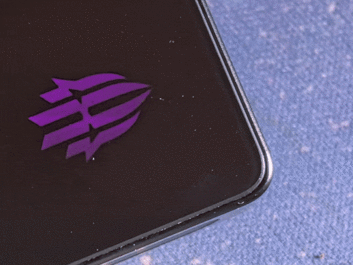The Nubia Red Magic 10 Pro is a very powerful smartphone, perfectly optimized for gamers. You can use additional triggers, connect peripherals, and easily connect an external screen. The smartphone also comes with a girl.

The idea of smartphones for gamers doesn't really appeal to me. Hardware-wise, any flagship smartphone from any well-known brand can run any mobile game available in stores. This is in the best interest of game developers. It will also offer, for example, much better camera setups for taking photos. In practice, the situation turned out to be much more complicated. The Nubia Red Magic 10 Pro comes with additional gaming buttons, an interface dedicated to specific gaming settings, and for anime-loving gamers, it offers an adorable talking personal assistant that not only can be animated on your wallpaper, but can also react in specific, pre-defined smartphone usage scenarios. Perhaps I was wrong in my assumptions...
photo: J.Filipowicz for GSMchoice.com
What's in the test kit?
- Smartphone Nubia Red Magic 10 Pro (black - Shadow, but also available in white - Moonlight and semi-transparent - Dusk)
- 80W charger
- USB-C to USB-C cable
- Semi-transparent back cover
- Pin for opening the nano-SIM card tray
- Documentation (quick user guide also in Polish)
Please check the contents of the box before each purchase, as it may vary depending on where you purchased it. The test smartphone comes from official Polish distribution, but European regulations may require different contents in an alternative package. The inclusion of a decent charger is commendable, though I would have preferred a USB-A to USB-C cable. I don't have USB-C in my desktop. The back covers certainly contribute to the smartphone's security by protecting the corners and short edges of the device, but in my opinion, they detract from the smartphone.
photo: J.Filipowicz for GSMchoice.com
A solid, sturdy box in elegant gray and black. If I were the manufacturer and distributor, I would consider adding slightly more vibrant colors, as the target audience should know what they're buying from the start, and the contrasting, color-saturated display perfectly justifies the bold color on the packaging. I'd be happy with Mary, who's already promoting the interface, even though I'm not a young gamer, but that's just my opinion.
photo: J.Filipowicz for GSMchoice.com
The paper manual, written in Macintosh, doesn't contain much information, but it does contain the most important information: a description of every element of the external design: buttons, ports, etc., how to turn it on and off, how to charge, how to insert a SIM card, how to wake it up. All with illustrations, three pages long. I couldn't find a manual on the Polish Red Magic website, and the support link refers to a third-party company where you can get help if you need to repair it, but there's no proper manual either.
Every smartphone should look like this
- Front camera under the screen
- Invisible rear cameras
- 3.5mm jack
- Stereo speakers
- Additional triggers for gamers
- Additional customizable switch
- Fingerprint reader under the screen
- Cooling with a physical fan
Design-wise, the Nubia Red Magic 10 Pro is the smartphone of my dreams. A long time ago, Sony decided to release the Xperia Z and Xperia Z2 – I had the latter and loved using it. A bold, curve-free body, sharp angles, and a minimalistic color palette: black and silver. The Nubia Red Magic 10 Pro, however, offers much more. The glass back and front are almost flat; the curves characteristic of modern smartphone design studios are absent – they are softened by subtle edges where the edges meet. The only colors are the dominant black, softened by a geometric pattern on the back, the red of the Competitive Key, and the dark gray of the additional triggers. The aluminum frame, which heralds lightness and durability.
photo: J.Filipowicz for GSMchoice.com
The geometric pattern on the back seems to be achieved by varying light polarization in the layers covering the case. It shimmers when you tilt the smartphone. The sharp metallic red of the Competitive Key is further accentuated by its serrated texture, making it easier to slide when turning it on. In gaming mode, two additional illuminated symbols in the upper right and lower left corners of the smartphone are activated on the back.
photo: J.Filipowicz for GSMchoice.com
I'm constantly amazed by the elimination of the front camera, which smartphone manufacturers have accustomed us to, and which incredibly detracts from most displays. The under-screen camera is a wonderful solution because it makes the entire screen available to the user. It appears clearly on the display only in competitive gaming mode. There's also a fingerprint reader under the screen.
photo: J.Filipowicz for GSMchoice.com
The camera section also brings an irrepressible smile to my face: they don't protrude from the casing! Of course, we'll pay for this with less photographic capabilities than in typical flagships, but still: they don't protrude from the casing. There are two, and in the camera section, there's an additional visualization of a fan with blinking colored LEDs beneath them. This is, by the way, a configurable backlight. The only element that slightly protrudes under the fingertip is the LED flash. The only reasonable explanation for this protrusion is probably the anti-slip protection. If so, it doesn't work very well: the smartphone slips off any surface, even the slightest tilt. Below the LED flash is another optical element. This is a macro camera. Below the camera section, we have a slightly concave logo and the name of Nubia's gaming smartphone series, as a decorative addition.
photo: J.Filipowicz for GSMchoice.com
The right edge houses all the protruding elements, including the round power button, the sliding Competitive Key (switches to competitive mode for gamers, but additional functions can be assigned), and the volume control. On the opposite edges, there are also two highly sensitive touch triggers dedicated to gaming. Approximately 1/4 of the height of the smartphone, but from the top, on both edges are the cooling system grilles; on the left is the air intake, and on the right is the exhaust. This is probably the only design element of the Nubia Red Magic 10 Pro that raises some concerns for me due to the possibility of getting dirty during everyday use. It's worth remembering that the smartphone doesn't boast any IP rating. You just have to be careful with moisture and dust. At the bottom, at a similar height, there's a hole. This is an additional third microphone used in games, as described.
photo: J.Filipowicz for GSMchoice.com
On the top edge, we have the microphone hole, the speaker grille, the infrared port, and the 3.5mm headphone jack socket. I like the convenience of wireless audio, but it's so good to listen to music on this smartphone with your favorite wired headset! The left edge houses – as I mentioned – a twin opening for the cooling system, while the bottom edge houses the SIM card tray, microphone for calls, USB-C port, and the speaker grille, identical to the one on the top. The SIM card tray is a model of minimalism, as it holds both cards on the same surface: double-sided.
For gamers, not photographers
The Nubia Red Magic 10 Pro has three cameras on the back, one on the front below the screen, so it's invisible in everyday use. The main camera is equipped with an OmniVision OV50E 1/1.5" module with a 50 Mpx matrix, f/1.88 aperture and 1 micrometer pixel size. The matrix is capable of taking photos at a resolution of 8192x6144 px, but by default, photos are taken at a resolution of 4096x3072 px. To take a photo in full resolution, you need to dig a bit in the camera interface [The option was present in: camera family --- full size (sic!), but after the first update, the "camera family" was named "more", and the option itself mysteriously disappeared and I can't find it in the settings]. The camera lacks PDAF and optical image stabilization. The second camera has a wide-angle lens with an f/2.2 aperture and an OmniVision OV50D 1/2.88" sensor with a similar native photo resolution to the first one, but with slightly smaller pixels - 0.6 micrometers. The macro camera is powered by the OmniVision OV02F module, which means 2 Mpx and photos of 1600x1200 px with an f/2.4 aperture. The front camera, hidden under the screen, is also an OmniVision sensor, this time the 16-megapixel OV16E10. For selfies, a native resolution of 4656x3496 px is used.
photo: J.Filipowicz for GSMchoice.com
It's difficult to say anything about the Nubia Red Magic 10 Pro cameras. It's impossible to speak in superlatives. This is one of those aspects of a smartphone that Nubia should seriously work on. Does this mean bad photos? No. It means software that doesn't always cope with the truly decent hardware. The main camera can automatically, without blur or adjustments, take two photos with very different color dynamics. One is really good, while the other dulls the colors and kills the contrast.
photo: J.Filipowicz for GSMchoice.com
You'll take a night photo that won't be off-putting. You can even take a photo into the sun – and that's good too. The problem is that when taking photos with these cameras, I never knew what I'd get. It's reassuring that most photos are acceptable, some are decent, and a few are even very good. Good lighting conditions are usually the guarantee of a successful photo. Focus is generally not a problem, although I've had unexpected depth of field issues. I post photos of conifers and leaves, where you can count the needles in the evening light and there's no soapy effect, but there are also photos where you could wash an elephant with the soap. There are no issues with color reproduction, although red takes on very different shades.
photo: J.Filipowicz for GSMchoice.com
I think that with a camera with a wide-angle lens, you could even save money and use 8 MP. I expected good results, but I got very average ones. There are issues with dynamic range, and the distortion correction can be disappointing. The front camera, on the other hand, takes decent photos, but they sometimes seem overly aggressively HDR-enhanced. Color reproduction is quite nice, but you have to be careful, as the camera under the display can suffer from lens flare if the sun accidentally hits the screen.
The Nubia Red Magic 10 Pro records video up to 8k at 30 fps. Other video modes:
- 4k at 30 and 60 fps
- 1080p at 30 and 60 fps
- 720p at 30 fps
Stabilization works everywhere except 8k. Time-lapse video can be saved in 720p, 1080p, and 4k. Here's a funny but comforting thing: when I received the smartphone for testing, the option was called "Time Lapse," but after the first update, it's now called "Time Lapse." Kudos to the Polish manufacturer and Nubia for listening to the Polish translation requests. For slow motion, you can choose 120, 240, or 480 frames per second, but the interface doesn't provide any information about the video resolution, which is disappointing. So, I'll add: 120 fps at 4K, 240 fps at 1080p, 480 fps at 720p.
photo: J.Filipowicz for GSMchoice.com
I must admit, after viewing the photos, I was very pleasantly surprised by the video quality. The autofocus responds quickly enough to changes in depth, and the image stabilization works smoothly and flawlessly. Color reproduction both outdoors and indoors seems quite accurate. I was able to test video quality up to 4K, but unfortunately, 8K only with down-sampling because I don't have a suitable display. Overall, I think the user should be satisfied. I've seen smartphones with larger hardware capabilities (in terms of sensors) with significantly worse results or even recording errors (frame delays, AF, and OIS).
Photo and Video Interface
Where Nubia opted for pictorial illustrations for options, I can only praise them. The "More" option in the photo interface is adorned with illustrations. Here, you can light paint, trace star trails, switch lenses, take a photo of an ID or ID, shoot a panorama, use filters, and overlay two photos (a sort of double exposure). The professional interface looks nice, with the ability to capture photos in RAW format, display a histogram, and change almost all settings. You can switch between the main and wide-angle cameras directly on the screen. You can choose from two color schemes, using natural or vivid colors. There are separate toggles for night photos and portraits with background blur. AI can also be disabled.
photo: Nubia, J.Filipowicz for GSMchoice.com
I had a bit of a problem disabling the bar with the brand and basic parameters, which is intrusively enabled by default in every photo. The option to disable it is buried as deep as possible. Not great. A bigger problem was the recent update, which not only corrected the translation errors (and brought more), but also changed the availability of some of the options described above (full-size photo) or the default resolution of the resulting photos. While the 50MP sensor previously took photos at 12.6MP by default, now it sometimes takes 7.5MP and sometimes 12.6MP. What's the deal? I have no idea.
photo: Nubia, J.Filipowicz for GSMchoice.com
Mara, the girl on the screen
Nubia is a Chinese brand, but Far Eastern culture accepts certain things on equal terms. In Japan, moe gijinka are popular – literally, the term means "moe personification," where "moe" refers to feelings of sympathy for cute characters, and "gijinka" literally means "personification." It includes OS-tan (personifications of operating systems), but also other characters personifying things like web browsers, games, or even inanimate objects – like smartphones...
photo: Nubia
And why am I writing about such exotic things here? Well, because Mara lives in the Nubia Red Magic 10 Pro. If you're not really into anime style, don't bother trying to get to know Mara. It's not worth it. Even though Mara appears with four different biographies, in different outfits, and even talks to the user in specific situations while using the phone, she can still make him wake up at a specific time or remind her that it's time to rest. After all, she'll always be a character from a Japanese manga, or rather, anime, since she's animated, after all. I'm just pointing out that she's not particularly annoying (who would willingly put up with an annoying animated girl?), but to a prudish user, she might seem immodestly dressed. And she probably only speaks English.
photo: Nubia
Mara, who has a slightly nasal voice: she can change costumes, stretch, whistle, play on her own smartphone, get ready to take pictures in the rain, try to read a book, try to wink while making sure we don't touch anything, laugh like a ferret, take a bite and a drink, get angry, call her owner "commander," change her hair color from pink to fiery orange, get excited about snow and suggest building a snowman, make a birthday cake, react to an earthquake by suggesting hiding under the table, knock on the screen, suggest a break from gaming, be happy it's Friday, and console us that the Monday blues have no access to us. It can also scold you if you touch the screen in a politically inappropriate place, informing you that there are no buttons there.
photo: Nubia, J.Filipowicz for GSMchoice.com
You can also choose not to launch Mary at all, or run it for fun in a thumbnail, or use it as a full-screen animated wallpaper with AI chatting and changing poses in response to user actions. Has anyone seen the second Blade Runner? Wait a minute until manufacturers realize that implementing online AI is no art, that it doesn't even have to be an anime character, and that lonely users love it. Solitude will take on a whole new dimension.
Hardware
The Nubia Red Magic 10 Pro is powered by a Qualcomm Snapdragon 8 Elite processor. You don't need to know how many cores it has, what AI engine it uses, or clock speeds. Currently, it's the most efficient smartphone unit on the market, especially when paired with fast LPDDR5X RAM. This smartphone is available with either 12 or 16 GB of such memory. Depending on the version, there's a total of 256 or 512 GB of UFS 4.1 memory for the system, software, and installed games. Genshin Impact maintains a frame rate of around 60 fps, but benchmarks can push the limits and reach a maximum of 144 Hz.
J.Filipowicz for GSMchoice.com
A remarkable detail here is the physically operating fan and dynamic airflow within the casing. It dissipates heat nicely, spinning at 23,000 RPM, although the casing still heats up under heavy load, effectively dissipating this heat thanks to "liquid metal" (it's hard not to smile at that name). But there's also copper foil under the screen, a graphene plate, thermal gel, and an aluminum heatsink, and that's something I'm really drawn to. It flashes LEDs, and you can activate it both manually and automatically. How did they fit 58 blades into this micro fan? Marvelous, but I'm still, as usual, concerned about the durability of this type of mechanical component in a smartphone.
photo: Device Info HW, J.Filipowicz for GSMchoice.com
The second unusual detail is the touch triggers. They're sensitive, that's for sure. The manufacturer states the touch sampling rate is 520 Hz. They simply work as they should, although I still prefer mechanical and slightly larger ones.
The 6.85" OLED display is commercially called Infinity Display and operates at a resolution of 1216x2688 pixels at a maximum refresh rate of 144 Hz, with a peak brightness of 2000 nits, which is good for this segment. To clarify, the maximum global brightness is 1600 nits, which is still an impressive result, and in addition to the maximum refresh rate, you can also set slightly lower values: 120, 90, or 60 Hz. A reasonable compromise for battery life is the auto setting, which adjusts the frequency to what's being displayed. There's no point watching YouTube at 144 Hz, right? The problem is that it's counterintuitive: a fixed 144 Hz setting won't result in video services being displayed at 144 Hz, only at 60 Hz. It makes sense, but why isn't this mentioned in the option description? Unfortunately, I wasn't able to test the battery life to compare both settings. It's difficult to replicate the same usage scenario.
photo: Geekbench, J.Filipowicz for GSMchoice.com
The camera under the screen works well, and the fingerprint reader under the screen usually works on the first try (not every time: such under-screen readers still don't exist). You know how nice it is to watch movies and play games without a hole in the screen? No? That's unfortunate. The screen is protected by Corning glass, although I wouldn't throw the smartphone after a failed match in Dragon Ball Legends or Mortal Combat. The bezels on all sides are 1.25 mm thick.
The battery has a capacity of 7050 mAh, and despite such a large capacity, don't expect it to last very long during intense gaming, although compared to other gaming smartphones, the battery life is impressive. Such a capacity for a smartphone at 8.9mm thick, it's a miracle. The second miracle is that this thickness isn't counted "without the camera island," because there's no island here. The manufacturer promises up to 6 hours of Genshin Impact playtime. Well, I didn't manage to achieve that much, but I understand that "up to" also means less than 6 hours. 52 hours in standby mode is possible, because I tried it. It will last as long as you put it aside and don't use it, and keep the internet and other things running in the background are turned off. With very light use, it lasts about 48 hours. It's difficult to give strict usage scenarios for this type of smartphone. Used like a regular smartphone, with apps running in the background and data exchange, it will probably last a day, at least from morning to evening, with an evening charge. If you're a gamer, don't expect miracles. The charger charges really quickly, although it would charge faster if it were 100W (because that's the current that can charge a smartphone) rather than 80W. It reaches over 90% in half an hour. About 33-36 minutes to full charge. While charging, you can and should turn on the fan automatically.
I could go on and on about the wonders of the sound chambers and the music flowing beautifully like Aquaman on potato pancakes, but the music on the stereo speakers isn't mind-blowing. These are tiny smartphone speakers, equipped with impressive technology, but physics is physics. However, it really shines when you connect decent headphones to the jack. Oh yes, then it's like this. The smartphone, on the other hand, handles truly non-audiophile music in games very well. Symphonic pieces from Genshin flow smoothly, and it's a pleasure to play without headphones, although it's not worth listening too loud, because then the highs start to buzz.
System and graphical interface
The Chinese manufacturer seems to have missed market trends. When most brands extend their support period and the number of guaranteed system updates. The Nubia Red Magic 10 Pro runs Android 15 and the Redmagic OS 10 overlay, but you won't see Android versions above 16. One guaranteed system update. Thank goodness security updates are guaranteed for 3 years.
J.Filipowicz for GSMchoice.com
By default, the Competitive Key (I found at least two different official Polish translations, so I don't want to risk translating it, as there's probably no good translation... "competitive mode"?) switches the smartphone to gaming mode. A "jet animation" plays, the screen locks in a vertical position, and a completely separate interface launches, with pleasant background music playing. Space as usual. On a side note: if you're not a fan of games (which isn't surprising, because a smartphone is already great), the Game Space button instead of the Game Space button allows you to set the camera, flashlight, voice recorder, or toggle the sound mode. But let's get back to the game space.
photo: Nubia
The system shows a lot of AI-powered elements, especially in Game Space, where the AI ensures the hardware's processing power is redirected to the needs of the identified game and displays additional game-related information while playing. Game Space is essentially a completely separate interface dedicated to gamers, divided into two parts: "Game Gallery" and "Superbase." The Superbase has several options:
photo: Nubia
- Gravity X lets you customize your smartphone's gameplay experience, offering the ability to connect external controllers like a keyboard, mouse, or gamepad. It's also possible to broadcast the game to a larger screen and use the smartphone as a controller. Z-SmartCast uses a TV, monitor, or projector. The app requires permissions for location, voice recording, and camera interface. The smartphone uses Miracast for wireless streaming, but you can also connect wired via USB-C, which has a connector on the other end appropriate for the target device: HDMI, VGA, DVI, or DP (purchased separately). Once connected, screen sharing set to mirror mode works automatically, provided you select the correct input source on the target device. It's also possible to use a USB-C cable alone, provided you have the Redmagic Studio app installed on your PC or laptop – simply connect the devices with a cable, select "USB Casting" on your smartphone, and select the USB connection type in the software on your computer.
- Red Magic Time is a space for managing game casts.
- The plugin library, in turn, contains game add-ons that allow you to access additional information and options during gameplay. Unfortunately, the plugin descriptions are rather cursory and poorly translated, so to understand what a given plugin does, you usually have to enable it. While the audio equalizer, numeric buttons, and crosshairs on the screen are quite intuitive, things like "excellent image quality," "AI trigger," and "audio and visual probes" are not necessarily so.
- Mora's interface – the girl on the screen, which I wrote about above.
- Behavioral Learning – this is actually more of an option, but it has a separate section. Once enabled, the AI will learn the player's gaming habits and try to intelligently adjust or preserve the interface and settings.
photo: Nubia
The quality of Game Space is severely limited by poor translation of some options, as well as a lack of help to understand how they work. Connecting peripherals and screencasting are well described. Plug-in options are poorly described. It's great that you can play in the cloud or stream your gameplay live. This type of software, along with hardware features like a powerful processor, fast memory, triggers, and a screen without a camera, reasonably justifies calling a smartphone a gaming smartphone.
photo: Nubia
The graphical interface can be customized to your preferences in almost every respect: color quality and type, three native themes, size of interface elements, fonts, behavior of individual applications (with the ability to adjust the volume for each application separately), one-handed operation, protection against accidental touch, resolution, display refresh rate, etc., etc. Furthermore, I had developer options enabled by default on the test smartphone. I don't know if this is the rule or the exception with the Nubia Red Magic 10 Pro.
Summary
I admit that after three weeks with the Nubia Red Magic 10 Pro, I look at gaming smartphones a bit differently. In terms of hardware, I think it's a smartphone optimally suited to providing gamers with comfortable gameplay, connectivity to peripherals, and participation in the gaming community. The additional controllers are nice, but what's much more valuable to me is the ease of connecting controllers and peripheral displays. To anyone considering mobile entertainment when choosing their next smartphone, I recommend the Nubia Red Magic 10 Pro without hesitation. As of July 2025, the smartphone costs €599.00 for the 12/256 GB version and €749.00 for the 16/512 GB variant.
J.Filipowicz for GSMchoice.com
However, it's worth remembering that this isn't a smartphone offering the highest photo quality available on the market – although I can still recommend it for video recording.
I'll remember the Red Magic 10 Pro primarily for its design, which suits my taste, the lack of an unsightly camera display, and the friendly Mara speaking to me on the screen in English, but with a distinctive accent that's hard to forget.























































































































































































































